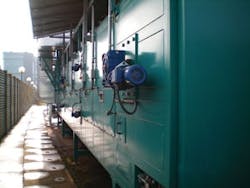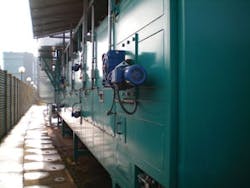New security regulations governing the use of toxic and hazardous chemicals are in the future for water and wastewater treatment plants. Of primary interest are chemicals such as chlorine, sulfur dioxide and ammonia used in these facilities, their containment and the prevention of their release to the surroundings both inside and outside the plant boundaries.
While containment of the hazardous chemicals can be provided by a scrubbing system, such systems can be capital intensive. Scrubbing systems also may require frequent servicing and periodic operation to insure that the entire system is operational.
An alternative system in use at water and wastewater treatment plants is the Automatic Valve Operator (AVO) as provided by Halogen Valve Systems. The valve operators are much simpler than scrubbing systems and automatically close any open valve on compressed cylinders or containers when a problem is detected.
The Halogen AVOs, which will be on display at ACE'10, can close valves in less than one second after activation. The systems can be activated with electrical contacts created by fire alarms, gas leak detectors, seismic devices or remote electrical control systems like SCADA. A plant operator also can activate them with a panic button located outside the storage and use room or in the control room. Each AVO is electrically operated and is mounted directly upon the container or cylinder valve stem. The actuators are battery-powered and operate even during a power failure.
Halogen Automatic Valve Operators are designed to close valves on compressed gas cylinders or containers when a problem is detected.
Up to six cylinders or containers can be activated with one control system. The system provides an electrical contact after the closing and torquing of all cylinder and container valves.
Halogen AVOs are designed for electromechanical valve closure only. They are not designed to open the valve electronically, particularly after an incident which closed the valve. Manual opening of the valve by the operator is the only recommended safety procedure after the valve has been closed. This design requires visiting the site, examining the cause of the valve closure and correcting the cause before the system is restarted.
Specifically with chlorine gas, the Chlorine Institute has recognized the advantage of these emergency shutoff systems and has included their use in guidelines for cylinder and ton container valve operation.
Anywhere compressed toxic or hazardous gases are used in a process application, there is a need to consider the safety and security of the containers in storage and use. Halogen AVOs are in use in medium and large facilities where multiple chlorine ton containers are in operation as well as in small well sites where only one or two chlorine cylinders are in use.
More WaterWorld Current Issue Articles
More WaterWorld Archives Issue Articles




